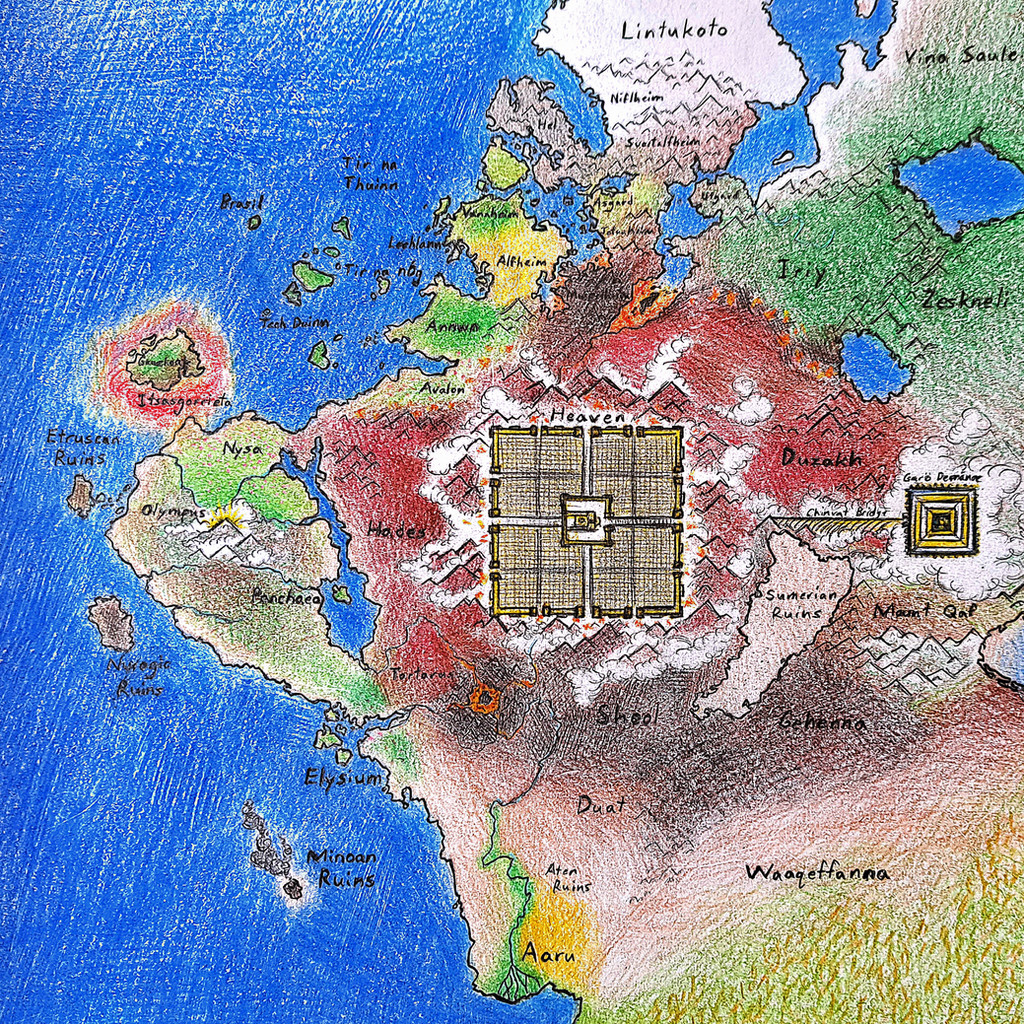HOME | DD
 Avapithecus — Map of the Jurisdictions circa 536 CE, version 1.0
Avapithecus — Map of the Jurisdictions circa 536 CE, version 1.0

#afterlife #fantasy #map #mythology
Published: 2024-01-05 15:40:25 +0000 UTC; Views: 4476; Favourites: 41; Downloads: 0
Redirect to original
Description
Much like Minecraft, the Drake Hero Universe consists of three primary dimensions, or I suppose “planes” in D&D terms. First and foremost is the real world, what I might be tempted to call Midgard. This is obviously the realm we live in and interact with on a daily basis. Secondly, there's the Jurisdictions, a parallel world intertwined and overlapping with our own, where all the legendary locations and afterlives integral to their respective mythologies vie for space. I mean that literally, as the ground here is not as set as Earth's tectonic plates are. Human belief is what keeps a Jurisdiction afloat. The more believers you have, the wider your borders grow. The less you have, the more your Jurisdiction crumbles into the abyssal sea of forgotten gods and monsters. The last plane is the Apeiron, the mechanism under the hood of both worlds, a Lovecraftian place where physics are more of a suggestion and illusion is indistinguishable from reality, but that's a spoilerific tale for another day.I mentioned a while ago that I'm working on a project set in 536 CE. That's still being constructed in the background, slowly but surely. I don't want to give any sort of impression that it'll be done any time soon XD It's a big project, and it's a big project that needs lots of maps. Maps for planet Earth are straightforward enough, but to get my bearings on all the stuff set in the Jurisdictions, I decided I needed a visual guide. Ergo, the map! This is only meant to be a proof of concept, as I'm sure there's plenty of nooks and crannies that will need to be adjusted as I do more research on mythologies I'm not as familiar with. This is also only one corner of a much bigger map, since ideally the Jurisdictions include the realms of every mythology of every culture on planet Earth. So feel free to comment any critiques you think should be included for the next version or the smaller zoom-ins I'd like to do in the future! By its nature, this map is meant to shift around and contort as time goes on, so I'd appreciate the suggestions







All that being said, let me go over the design notes for this draft so far. While I intend to stretch the 536 project across more mythologies than are depicted here, this encompasses the cultural sphere that most of the story will interact with. As you can tell, it mostly just covers “stuff the Romans knew about”. In that vein, I've centered the map on the Abrahamic Heaven, here represented as a giant square city as per the description of the “New Jerusalem” in the Book of Ezekiel and the Dead Sea Scrolls. Surrounding Heaven on all sides are the various conceptions of Hell as it came to be understood in the Roman period (hence why Hades and Tartaturs are heavily spilling over into the Christian Jurisdiction). I think this is a neat way of representing how pagan faiths were traditionally viewed through a Christian lense: that from Heaven, one can only see Hell for as far as the eye can see outside, and to traverse from paganism to Christian salvation, one must cross through Hell first. This also serves a function in the way the Jurisdictions work. As Christianity becomes more and more popular and widespread across the course of human history, Heaven's space grows, but in tandem so does Hell. So it's not Heaven that's encroaching on the other Jurisdictions, but rather Hell, and the constant battle between angels and demons on the front lines always forces demons to retreat and claim territory in the Jurisdictions of other faiths, hence the perception in medieval Christian of paganism as “demonic”: the belief is literally taking over. The gods and monsters of these other Jurisdictions will have to decide if they want to adapt, assimilate, or fight for their borders, which will be a big aspect of the 536 project.
I've positioned the pagan Jurisdictions in a ring around the Abrahamic ones, trying my best to keep cultures who historically kept in close contact physically connected to one another as the Abrahamic bubble expands and pushes them away. The Germanic bubble is the most detailed because that's the one I've put the most thought into. I'll make up for my bias by saving a more detailed exploration for another day. Going counterclockwise, southwest of the Germanic Jurisdiction is the Celtic Jurisdiction, which is probably the one most subject to change. Irish and Welsh sources are notoriously scatterbrained, and it doesn't help that many of the primary sources are buried under a thick layer of modern influences trying to push an agenda born out of Victorian fairy culture or worse, nationalism. If anyone has some good, concise scholarly sources on Celtic mythology, please send them my way. I'm sick of plucking information from fairy lore websites that look like they haven't been updated since Y2K. The general consensus I've gotten is that the Celtic Otherworld is a series of strange magical island paradises situated far to the West of the Emerald Isle, so I took inspiration from the various phantom islands you find printed on old maps to create a sort of archipelago.
Going further south is the Greco-Roman Jurisdiction. I was a little torn on this one, because technically, Roman mythology can be classed as a distinct entity from Greek mythology. That was in the early days, though, and the Romans themselves went through every measure possible to give themselves an extremely Hellenized brand, so I decided it was appropriate enough to fuse the two here in 536. With all that in mind, it still didn't help me much. Greco-Roman mythology is very geocentric, like there's not very many “otherworlds” as it were. There's Hades and the various levels of the afterlife, sure, but think about it: the gods live on Mount Olympus, a real mountain, the Trojan War was a real event that happened in a real city, and the trials of heroes like Heracles and Odysseus, while supernatural, do still take place on mortal Earth. Maybe it's just a symptom of my uncultured ass not being as familiar with the classics as I could be. Again, suggestions are welcome.
Taking a detour into the sea West of the Greco-Roman Jurisdiction, we'll find some of those crumbling worlds I mentioned earlier. These are the remnants of all the pre-Indo-European societies of which we have any semblance of record of. The most intact of these is the Basque Jurisdiction, as this is still a living culture, but it has long since been Christianized and overwritten almost to the point of extinction. It's not nearly in such a state as the Etruscan and Minoan ruins, however, whose lands are all but lost to the abyss of forgotten languages. Etruscan mythology is primarily only remembered in the names of gods preserved by the Romans, while the very script of Minoan Crete remains completely untranslated. There's nothing there but speculation, and their gods are likely gone for good as a result.
Okay from here on out is where I started to get a little lazier since I'm not nearly as familiar with these mythologies. That's why the Egyptian afterlives here are just upside-down Egypt. I tried to justify this to myself by saying that this sort of how the Egyptians tended to align the cosmos anyway but nah, it's just a placeholder. Apparently there is a sarcophagus motif from the Middle Kingdom period called the Book of Two Ways which does serve as a sort of “map” of the route the dead take through the afterlife, but the images I've found online are extremely abstract and contain a lot of features I've never heard of, so more research will be needed. The furthest south of this map needs a lot more research too, as evident by the fact that I just slapped the name of the traditional religion of the peoples of the Horn on there rather than a specific place name. I couldn't find any references to an exact otherworld or underworld, but I'm happy to be proven wrong.
Technically next around the clockwise path is the heaven and hell of Zoroastrianism, but wedged in between is a few scant references to ancient Mesopotamian religions and pre-Islamic Arabian polytheism. This map is set in 536 CE, so the more fleshed out cosmology of Islamic doctrine hasn't had time to grow into anything beyond its cognates with other Semitic faiths yet. In my head, the Hindu Jurisdiction would be situated directly east of the Zoroastrian one, but I decided not to go that far both because I am woefully unequipped to tackle the many layers of Hindu cosmology and I didn't have enough space on the paper to try- And then directly northwest of all that are the Kartvelian, Slavic, Baltic, and Finnic Jurisdictions, all of which are faiths I'm tragically unfamiliar with given my current level of research. For now, they remain placeholders with uncreative geographies. Like I said, any advice/suggestions/source recommendations would be greatly appreciated! It'll be immensely helpful for planning draft 2.0





























